You may have come across the phrase ‘relicing’ in relation to guitars and the way they look. It’s been growing steadily in popularity for a while now and lots of guitarists like that reliced look.
If you’re not sure, relicing guitars is when you take a guitar and make it look worn, old and ‘vintage’. Often the guitar looks quite beaten up and heavily used. It’s a bit like distressing jeans or those jeans with tears and rips in them.

I’ll be completely honest and say I’m not a huge fan of it. I like my guitars to look as shiny and spotless as possible.
In fact a couple of years ago a brand new guitar of mine picked up a small ding only a few months after I got it. The mark itself was tiny and yet I was super disappointed! I wanted that one, along with all of my guitars, to stay as pristine for as long as it could.
So relicing doesn’t really do it for me. I’ve got an old Squier Strat I’ve considered doing a relic job on but for my decent, higher end guitars – no thanks!
But this isn’t a ’10 Reasons Why Relicing your Guitar Sucks’ article… although I might do that at a later date. I’m here to inform not lecture, and you probably couldn’t care less what I personally think. Plus I’m not particularly bothered if other people like relicing their instruments. It’d be a boring old world if we all liked exactly the same things!
So let’s take a look at what relicing is, why you might want to do it, how to do so and more.
What is Guitar Relicing
Guitar relicing is when you give a guitar a very worn appearance. You take a new or well looked after guitar and ‘distress’ it by artificially aging the hardware or adding scratches and dings to the body.
It can range from a minimal amount of relicing or ageing – small nicks or scratches to the paint and some discolouration – through to really heavy wear and rusting of hardware.
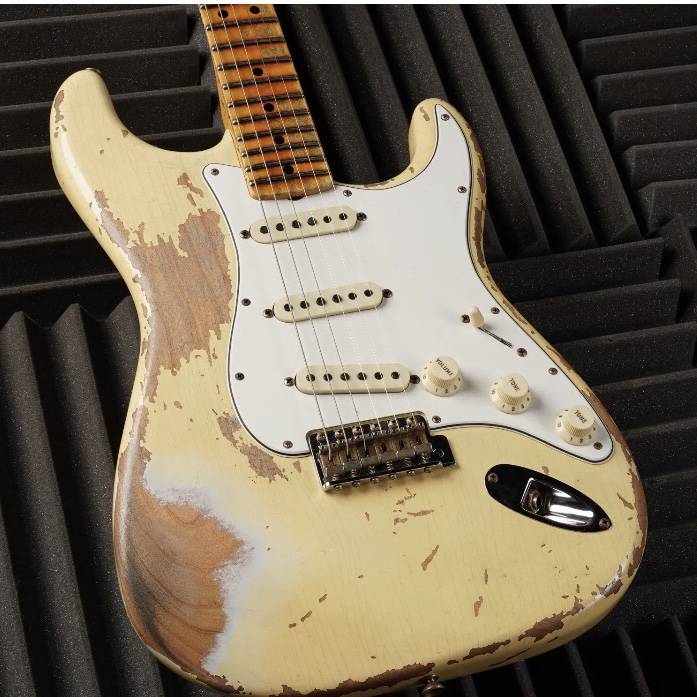
You come away with a guitar that looks like it is very old, has been played hard and that it’s taken a beating over many years.
The idea behind it is that the instrument ends up looking more collectible or vintage. It will give the guitar a lot of character and makes it stand out from the crowd.
You can also buy guitars that have been pre-reliced – so you’re buying it with that worn look.

The History of Relicing Guitars
The idea behind relic’d guitars actually comes from one of the most iconic guitarists of all time – Keith Richards.
The story goes that before the Rolling Stones were due to go on tour in the mid 90’s Keith bought a few Fender Custom Shop 52 reissue Blackguard Telecasters. When they arrived he took one look at them and sent them back to Fender because they weren’t worn enough. Apparently he’s quoted as saying “beat them up a bit first and I’ll play them”.
Someone must have been on the ball that day because it was soon after Fender had the genius idea of pre-distressing guitars before they were sold. They would ‘beat them up’, as Keith wanted, ageing them first then sell them that way.
And so in 1995 the Fender Custom Shop produced the ‘Relic Series’, with a few relic’d Stratocasters and Telecasters to try out the concept. They sold incredibly well and generated a lot of press coverage – good and bad! And all these years later relicing is as popular as it’s ever been.

Can You Relic Any Guitar?
There aren’t any real requirements for relicing a guitar. The major one is you will need it to have a nitrocellulose lacquer, or ‘nitro’ finish, in order to get a proper ageing look.
Polyurethane or polyester finishes are very tough and don’t relic well. They tend to chip rather than wear. Having said that I have seen pictures of naturally worn poly finishes but it seems to take decades.
For a relic job you either want to start with a body with a nitro finish – nitro is thinner and easier to damage so it’s looks more realistic – or refinishing a poly body with nitro first and then getting it reliced. It’ll work and look a lot better.
Why Relic a Guitar?
There are a few reasons you might choose to relic a guitar:
- Appearance – the most obvious reason is because you like the way it looks. Lots of guitarists prefer their guitar to look worn and well used. Others, like me, prefer a guitar as pristine as possible. It’s all down to personal taste.
- Authenticity – if you’re playing a certain type of music then a worn and vintage looking guitar may fit that style better than a brand new looking one. For example old school blues might be more associated with a worn out guitar as opposed to modern rock.
- Uniqueness – some people want their guitar to be a one of a kind and completely unique. If you relic and really wear it out it adds personality and becomes ‘yours’ and synonymous with you.
- Value – relicing a guitar can actually increase its value in some cases. As a lot of people like the relic look it may increase your chances of selling a guitar to relic it and even command a higher price (although it can also decrease the value too).
- A Project – if you’ve got an old guitar that you don’t care about lying around and want to do something with it then a relic job can be a fun way to bring it back to life. If you’re interested in relicing but aren’t confident about doing it with one of your better guitars then this is a good way to try it out.
- Covering Damage – for some relicing is sort of forced on them. They think if they’ve already scratched or taken a chunk of the finish out of their guitar they might as well do the rest!
Does Relicing a Guitar Damage it?
It depends what you mean by “damage”. The act of relicing is technically causing damage to it.
But if by damage you mean making the guitar unplayable or breaking it then it can happen through the relicing process. Usually this occurs when someone who doesn’t know what they’re doing or is inexperienced tries to relic their guitar.
You might end up sanding too much of the finish and damaging the wood of the guitar. Or when distressing the hardware you can corrode and break it by doing the relicing incorrectly.
That’s why it’s a good idea to use an old guitar you don’t care about if it’s your first attempt at relicing a guitar yourself.
But if you take your time, do proper research, use the right tools and techniques then it’s far more likely you will avoid causing any damage to your guitar. But if you’re worried the best thing to do is find a professional who does relicing. This will put your mind at ease about running your guitar as they are unlikely to make the mistakes you may have.
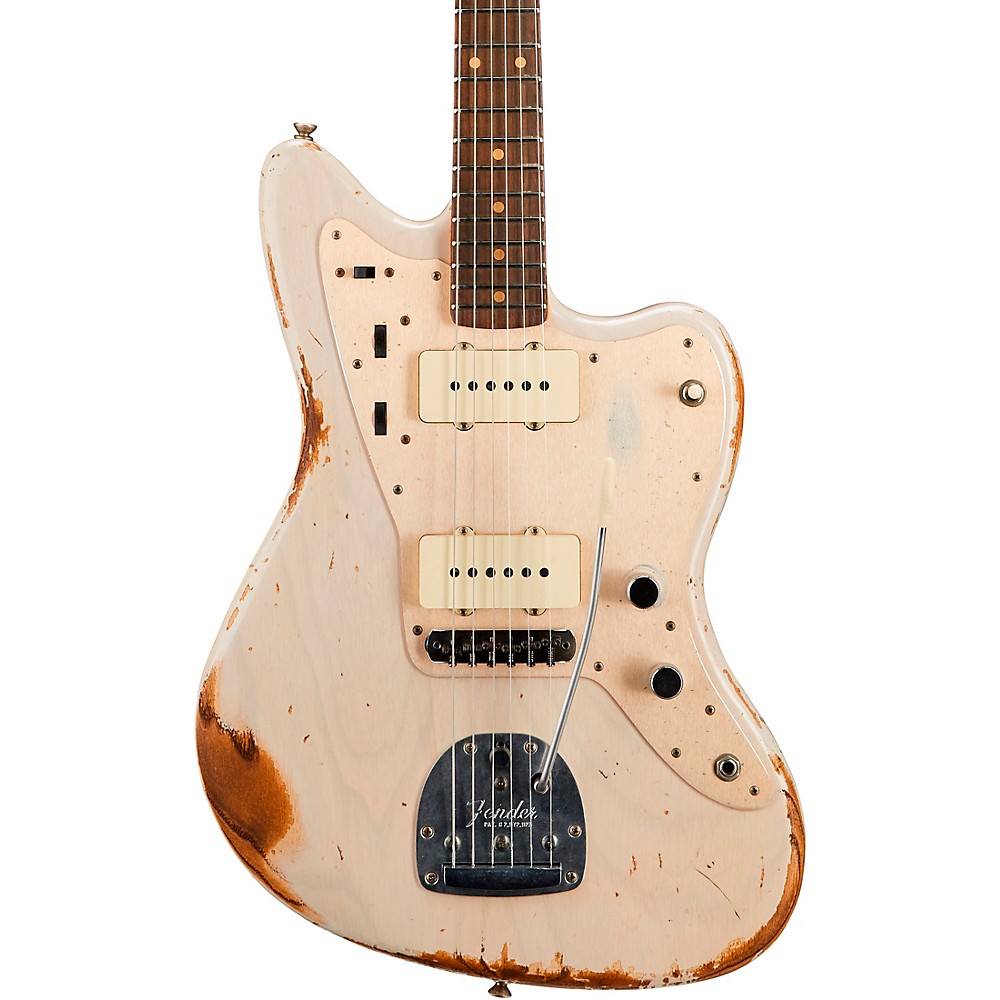
How Much Does it Cost?
If you choose to do the relicing yourself then it will cost less than getting a professional to do it. The cost of tools and materials will be the only real expense.
If you get a luthier to do it then it will depend on the type of relicing you want or they offer, the type of guitar and the reputation or skill level of whoever it is doing it.
There are often 2 different versions of ageing a guitar a luthier can do:
- A basic job that involves adding some dings and scratches to the body as well as distressing the finish.
- A more extensive job that ages the hardware, creates specific patterns of wear and tear or recreates a certain vintage look.
The first, basic option of these two will be the cheaper. The second will technically be a higher quality job and probably look better (depending on what you’re looking for) but will cost more.
For example Chicago Fret Works offer 2 different services. One that gets you a proper vintage look but is more expensive, coming in at $1000-$2000. The other is a more modern ageing that gets your guitar looking like it’s had 20 to 30 years of regular use and that costs $500-1000.
If you look around prices will of course vary but that should be fairly standard and average for relicing services.
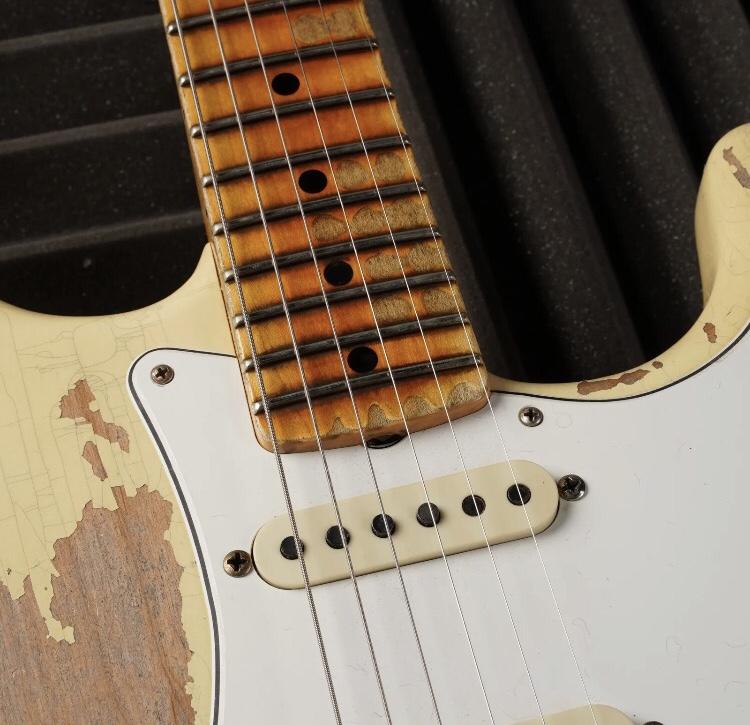
Who Does Relicing?
Guitar relicing is usually done by a guitar tech or luthier who have some of experience in ageing guitars. Quite often these are smaller or independent luthiers and technicians rather than big chains of guitar stores.
They will have spent time training and practicing relicing guitars and be familiar with different styles. They may even specialize in ageing guitars to look like they’re from a particular era.
Some of the larger guitar stores and music shops that offer maintenance snd repair will also do relicing. However specialized luthiers will probably be able to better job, especially if you want a very specific look.
Is Relicing Reversible?
It depends on the type and extent of the relicing. In some cases you will be able to restore the guitar to its original condition by refinishing it.
But some damage and changes during the relicing process may be irreversible. Or at the very least there will need to be a lot of restoration and repair work in order to get it back to its original condition. This could prove to be even more costly than the relic job in the first place or the price of a new guitar.
To give a quick example: if the finish on the guitar is sanded and distressed as part of the relicing then to reverse it you would need a complete refinishing job. That’s possible but expensive.
On the other hand if the hardware has been distressed or aged using chemicals then it’s likely the process is irreversible and you won’t be able to restore them to their original condition.
So it’s important to be aware that some or all of the relicing may be permanent before going ahead with it.

Do Guitars Naturally Relic?
Over time a guitar will usually pick up some general wear and tear. Unless you make a real effort to keep it perfect then it will naturally get scratches, marks and dings here and there.
If you gig with a guitar on a regular basis then it’s even more likely to get worn and knocked about. All of this could be considered “natural relicing”, in so much as relicing is trying to make a guitar look like it has aged naturally over decades of use.
However the term “relic” is referring to the process of artificially ageing a guitar. So it’s technically not possible to naturally relic.
Can you Relic a Guitar Yourself?
Yes, you absolutely can relic a guitar yourself. But it’s not easy and requires some skill to do it well.
For most people it won’t be worth the effort. It’s far easier to get a professional to do it knowing they’ll do a good job and have it looking the way you want.
But if you do choose to do it yourself then how you do so depends on how confident you are and what sort of look you want for your guitar.
For example one of the simplest ways is to use sandpaper or something abrasive to sand the finish down and create a worn look. You can also add dings and scratches to give a more authentic feel.
More complex is using chemicals like bleach to create a faded and distressed effect. Also on the hardware it will cause it to look aged.
But you run the risk of causing some real damage and it not working out as you planned if you go the chemical route. It’s unpredictable and not for beginners.
So if you are going to attempt to relic a guitar yourself do some proper research and planning beforehand. Be aware of the risks and if in doubt get a professional to do it so you avoid running your guitar.
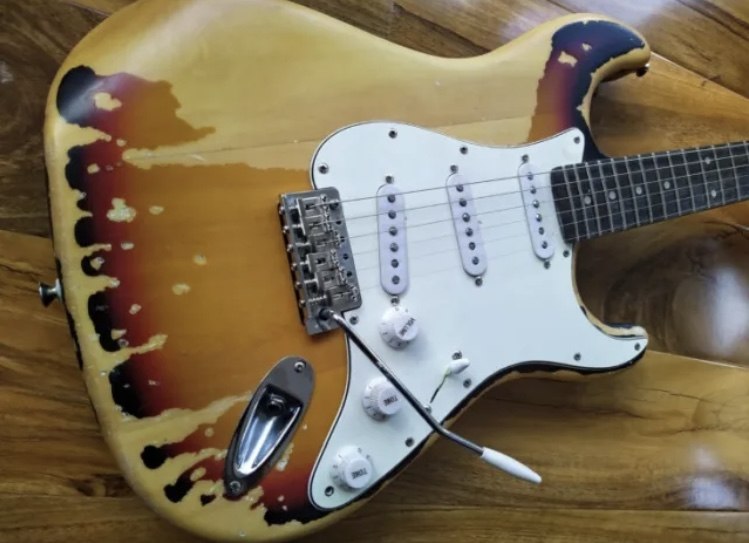
Which Parts of the Guitar Can You Relic?
Depending on how extensive you want your guitar to be relic’d you can choose which parts of the guitar to age. You might prefer a more subtle effect, so limit the relicing to just the body, or go all out and relic every part you can.
The Body and Wood
The body is the most obvious part to age and wear. But you can do the same to any part made from wood – so the neck and headstock too.
You might want to focus on certain areas of the guitar that would wear naturally from long term use. Think about where your hands rest on the body and neck, where the body rubs against you, the area below the strings and pickups when you strum, on either side of the strings etc.
The Hardware and Metal
If you’re going the subtle route with your ageing then you might want to pass on the hardware. If not then anything metal can be distressed.
The bridge, saddles, tuners, knobs etc. Scratching, filing and generally scuffing them up is the usual way to getting a really distressed look.
The Plastic
The plastic parts of the guitar are the easiest to relic and distress. You can just go to town on them with anything sharp and sand them down.
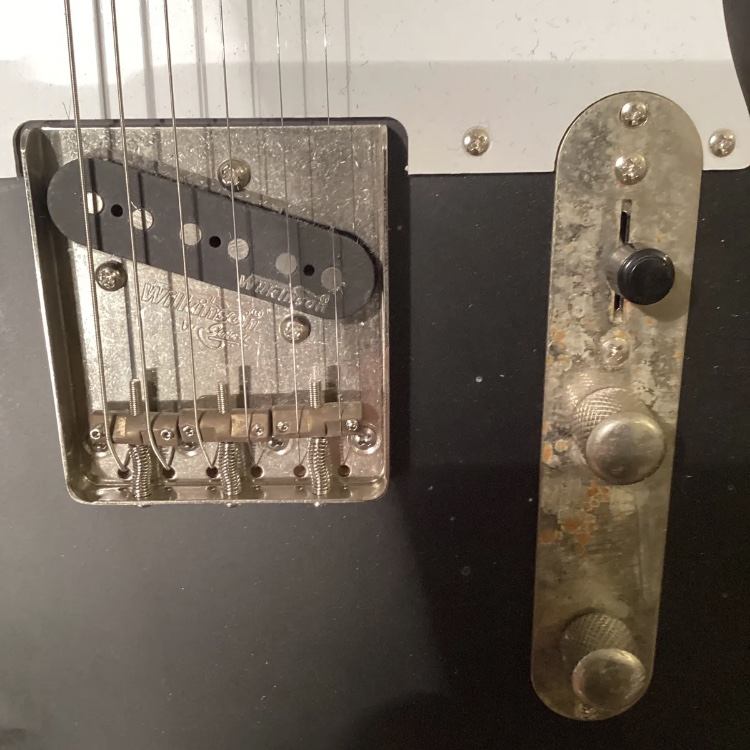
Why is there Controversy About Relicing?
It seems to have its basis in a group of guitarists who don’t like the practice of relicing. Partly because they see it as ruining a guitar, partly because it’s viewed as ‘fake’ and makes someone a poser.
Apparently you need to earn your well-worn guitar through years of slogging it out in dingy clubs, people spilling drinks on and taking chunks out of your favorite Strat. Otherwise it’s not legitimate and you shouldn’t make it look more worn than it really is.
From a personal point of view I don’t understand why people care. I’m not interested in relicing any of my guitars, it doesn’t particularly appeal to me.
But if other people like it – so what? It’s their guitar, if they want to make it look a certain way that’s entirely their decision. I can’t quite understand why it would work people up so much or provoke such a reaction.
But if you talk to guitarist or look at the discussions around relicing online you’ll see how strong the feeling is on both sides. It really gets under peoples skin. And seeing as relic guitars aren’t going anywhere the debate surrounding them will no doubt continue.
FAQ
Why is Buying a Reliced Guitar so Expensive?
You would be surprised by the skill needed to do a good relic job. It isn’t easy. It’s time consuming and requires a lot of experience.
So it adds a lot to the price of that guitar, which itself may already be fairly expensive. Together it makes for a pricey instrument!
Who Makes Relic Guitars
Fender are the most well known. Their Custom Shop was the first to build guitars with the relic’d, distressed look and began producing them in 1995 under the ‘Relic Series’ name. Gibson have since joined the party with their ‘Murphy Lab’ relic’d guitars and Gretsch do some too.